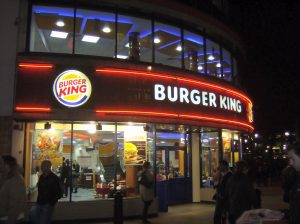8.3 Service Processes
As the Canadian economy has changed from a goods producer to a service provider over the last sixty years, the dominance of the manufacturing sector has declined substantially. As of 2017, only about 10 percent of Canadian workers are employed in manufacturing, in contrast to 30 percent in 1950.[3] Most of us now hold jobs in the service sector, which accounts for approximately 80 percent of Canadian jobs.[4] In 2013, WalMart was America’s largest employer, followed by McDonald’s, United Parcel Service (UPS), Target and Kroger. Not until we drop down to the ninth-largest employer—Hewlett Packard—do we find a company with a manufacturing component.[5]
Though the primary function of both manufacturers and service providers is to satisfy customer needs, there are several important differences between the two types of operations. Let’s focus on three of them:
- Intangibility. Manufacturers produce tangible products—things that can be touched or handled, such as automobiles and appliances. Service companies provide intangible products, such as banking, entertainment, or education.
- Customization. Most manufactured goods are standardized. Services, by contrast, are often customized to satisfy the specific needs of a customer. For example, when you go to the hairdresser, you ask for a haircut that looks good on you because of the shape of your face and the texture of your hair.
- Customer contact. You could spend your entire working life assembling cars in Detroit and never meet a customer who bought a car that you helped to make. But if you were a restaurant server, you’d interact with customers every day. In fact, their satisfaction with your product would be determined in part by the service that you provided. Unlike manufactured goods, many services are bought and consumed at the same time.

Here is one of the over nineteen thousand Burger King restaurants across the globe (Burger Kind, n.d.). Not surprisingly, operational efficiency is just as important in service industries as it is in manufacturing. To get a better idea of the role of operations management in the service sector, we’ll look closely at Burger King (BK). BK has grown substantially since selling the first burger (for $0.37) over half a century ago. The instant success of the fire-grilled burger encouraged the Miami founders of the company to expand by selling franchises.
Today, there is the BK company- and independently-owned franchised restaurants in 100 countries, and they employ over 34,000 people.[6] More than eleven million customers visit BK each day.[7] Burger King even purchased Tim Hortons in December of 2014. The acquisition was made for $12 billion making Burger King the third-largest fast-food service restaurant chain in the world. The company even moved its headquarters to Canada to assume a new tax nationality in order to reduce the corporate taxes the organization pays in the U.S.
SOURCE: “Our Burger Franchise Story,” https://franchising.bk.com/about#:~:text=Burger%20King%C2%AE%20is%20one,restaurant%20franchise%20owner%20are%20limitless, accessed July 17, 2024.

